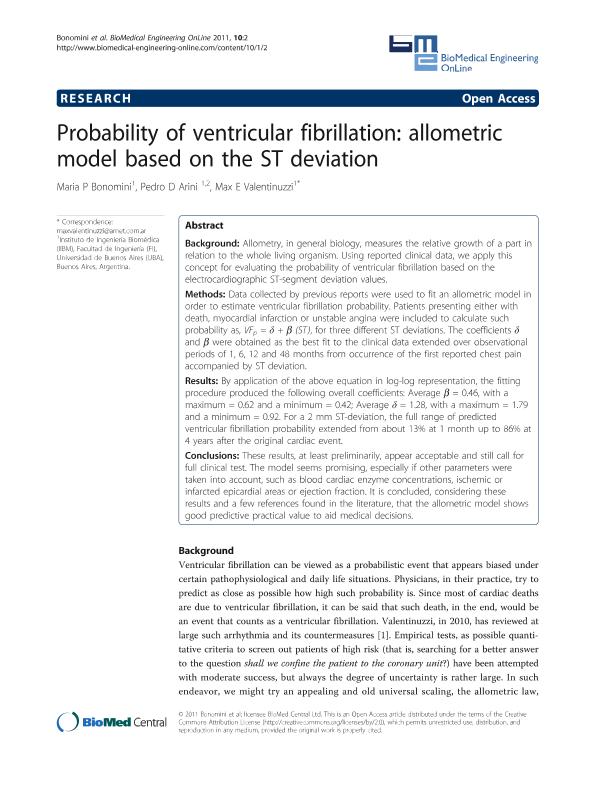Artículo
Probability of ventricular fibrillation: allometric model based on the ST deviation
Fecha de publicación:
01/2011
Editorial:
BioMed Central
Revista:
Biomedical Engineering Online
ISSN:
1475-925X
Idioma:
Inglés
Tipo de recurso:
Artículo publicado
Clasificación temática:
Resumen
Background
Allometry, in general biology, measures the relative growth of a part in relation to the whole living organism. Using reported clinical data, we apply this concept for evaluating the probability of ventricular fibrillation based on the electrocardiographic ST-segment deviation values.
Methods
Data collected by previous reports were used to fit an allometric model in order to estimate ventricular fibrillation probability. Patients presenting either with death, myocardial infarction or unstable angina were included to calculate such probability as, VF p = δ + β (ST), for three different ST deviations. The coefficients δ and β were obtained as the best fit to the clinical data extended over observational periods of 1, 6, 12 and 48 months from occurrence of the first reported chest pain accompanied by ST deviation.
Results
By application of the above equation in log-log representation, the fitting procedure produced the following overall coefficients: Average β = 0.46, with a maximum = 0.62 and a minimum = 0.42; Average δ = 1.28, with a maximum = 1.79 and a minimum = 0.92. For a 2 mm ST-deviation, the full range of predicted ventricular fibrillation probability extended from about 13% at 1 month up to 86% at 4 years after the original cardiac event.
Conclusions
These results, at least preliminarily, appear acceptable and still call for full clinical test. The model seems promising, especially if other parameters were taken into account, such as blood cardiac enzyme concentrations, ischemic or infarcted epicardial areas or ejection fraction. It is concluded, considering these results and a few references found in the literature, that the allometric model shows good predictive practical value to aid medical decisions.
Palabras clave:
Allometric Model
,
Cardiac Risk
,
St Segment Deviation
Archivos asociados
Licencia
Identificadores
Colecciones
Articulos(IAM)
Articulos de INST.ARG.DE MATEMATICAS "ALBERTO CALDERON"
Articulos de INST.ARG.DE MATEMATICAS "ALBERTO CALDERON"
Citación
Bonomini, Maria Paula; Arini, Pedro David; Valentinuzzi, Max E.; Probability of ventricular fibrillation: allometric model based on the ST deviation; BioMed Central; Biomedical Engineering Online; 10; 2; 1-2011; 1-8
Compartir
Altmétricas




